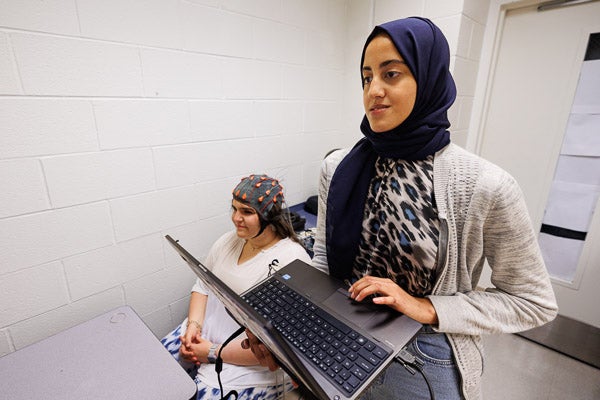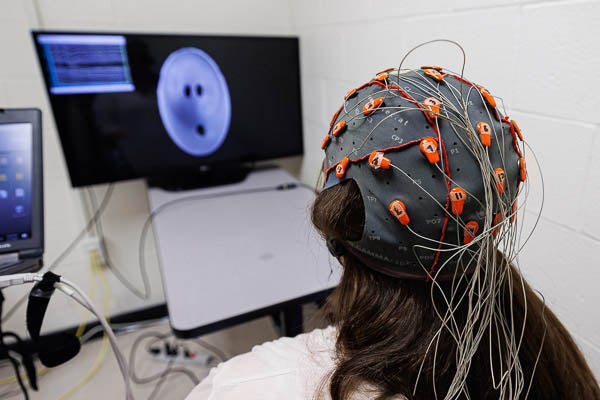Engineering professor looking for traffic jams in the brain’s highways
The human brain is like a complex group of highways, and despite a good road map, traffic jams may develop.
Sunghan Kim, an associate professor in East Carolina University’s Department of Engineering, hopes that a better method of understanding how these brain highways connect and affect one another could help diagnose cognitive brain issues.

Marwa Antar, a second-year graduate student in biomedical engineering, works with a student wearing a cap that measures electrical activity in the brain. (ECU photos by Cliff Hollis)
“My research team is trying to develop a platform that can monitor subtle changes of the brain due to various cognitive deficits such as sleep deprivation, dementia, anxiety, schizophrenia, ADHD or just normal age-related cognitive deficits so that they can be used to diagnose or at least help doctors and nurses quantify the changes,” Kim said.
Using electroencephalogram (EEG) to measure electrical activity in the brain, Kim and his team of students are looking at functional connectivity — the traffic flow of those brain highways — in the entire brain, not just one part of it.
“What we offer is to provide a more holistic view of those subtle changes,” Kim said. “We’re not talking about what looks different in a specific part of the brain. We want to see how the entire brain’s network has changed. For example, we’re not examining just the traffic pattern between Greenville and Raleigh. We’re analyzing the entire state of North Carolina and the entire country’s traffic pattern. It’s more of a system-wide analysis of the brain.”
Changes over time could indicate a problem or potential problem, but finding those changes is not easy.
“You have to do a lot of processing before you can quantify the changes because these are really subtle changes,” Kim said. “Making sense out of an EEG is more or less like trying to understand when a (child) is talking to (their) mom in a huge basketball arena when everybody is cheering for his or her team.”
The search is on
To find these subtle changes, Kim has elicited the support of a team of students, including Marwa Antar, a second-year graduate student in biomedical engineering. She directs a subject to put on a cap with electrodes that are designed to pick up the electrical signals that travel the brain’s highways.
“It’s very interesting,” Antar said. “I’m very interested in topics that study the brain and how different parts of the brain communicate and exchange information. It makes me look forward to the results we’re going to get. I’m curious about the topic.”
Antar is writing her thesis on the project, and once she gets her master’s degree in May, plans to pursue a doctorate in biomedical engineering. She believes the project is giving her valuable experience toward her goal.
She runs a computer program that produces a series of images, some of which are meaningful for the test subject, while others are not. Either way, the part of the brain that controls vision begins to send electrical signals so the image can be interpreted. If the image means something, different parts of the brain are engaged. A graph charts the activity.

Images shown on a screen create electrical activity in the brain that can be used as an indication of cognitive impairment.
Once a baseline is established, the subject is retested after getting little to no sleep.
“What will be the difference in the brain pattern before and after not getting enough sleep?” Antar said. “For this I’m applying multiple analysis techniques, mainly functional connectivity and graph theoretical analysis. … Applying engineering principles to study the brain is the main method.”
Outcomes
So why is this important? Kim points out that changes along the brain’s highways could mean trouble — dementia, addiction, schizophrenia, ADHD, anxiety or Alzheimer’s disease.
“If anything happens different in the brain, the EEG is going to look differently,” Kim said. “As you get dementia, as you get anxious, as you get depression, the difference between meaningful stimulation versus meaningless stimulation becomes less and less and less.”
Kim hopes that the use of EEG and functional connectivity analysis can lead to earlier diagnosis and better patient outcomes.
“You can do some sort of intervention. You can change your diet. You can do more exercise. You can do some sort of mental training. You can take different vitamins. If you know it, there should be something you can do,” he said. “There are a lot of dementia medicines that are being developed, and those aren’t for the last stage but before the onset so you can slow it, so you can delay it. So, instead of spending the last 10 years of your life in say an assisted living center or senior center, you can delay it and maybe spend just six months or a year toward the end of your life.”
The bottom line is a longer-lasting quality of life.
“If you know, so what? Aren’t you still doomed? Yes, but no. You can earn time,” Kim said.
He said the high costs of EEG and those who are needed to interpret the data are issues that need to be resolved. He wants to develop a portable and affordable EEG system that can become as routine as a blood pressure check.
“What if you could wear a cap every year or so when you become 50 or 60 to keep track of your cognitive decline?” Kim said. “Why do we only measure blood pressure or oxygen saturation? What about your brain, which is the most important part? It’s not being done right now. It’s not part of a routine right now because it is a hassle. And even if you record it, how are you going to analyze it? If someone can make it easy, accessible and affordable, then why not?”